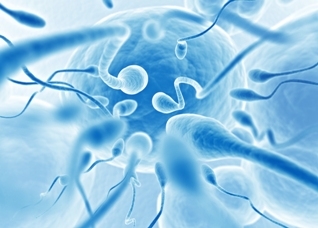Insemination

An insemination is often performed in case of procreativity reduction in the male. If the sperm count and motility are reduced, or if the amount of malformed sperms is high, insemination could bring the desired success. An insemination is also helpful when there are antibodies in the mucus of the uterine cervix. The latter prevents the sperm cells from making their way to the egg cell.
In an insemination, purified semen is injected through a thin catheter directly into the uterine cavity at the time of ovulation. The insemination is made on the gynecologist's examination chair. It is not painful and takes just several minutes. You can do your work before and after an insemination and do not have to rest afterwards. The insemination is performed either just before the ovulation in the natural cycle or after a hormonal preparation.
Insemination during the normal monthly cycle
It is not necessary to undergo hormonal stimulation prior to the insemination. You can determine the moment of ovulation at home with urine tests or have your cycle monitored through ultrasound examinations. The spontaneous ovulation can then be predicted. If the couple wants to plan the ovulation based on career or private grounds, it is possible to trigger one with an injection.
Insemination during a stimulated cycle
The ovulation is a prerequisite for the initiation of pregnancy. To accomplish that, a follicle containing the ovum is formed in the first days of the monthly cycle. When this follicle reaches a size of 18 to 24 millimeters, a hormonal signal is given by the pituitary gland. This causes the follicle to burs and the contained fluid brings the egg cell directly into the tube. There, the ovum awaits fertilization by a sperm cell.
In some cases, a hormonal stimulation of the ovaries is required, because:
- There is a hormonal disorder which prevents the ovulation
- A higher pregnancy rate can be obtained when more than one ovum is released in the ovulation
To this end, either pills (e.g. Clomiphen) or injections (e.g. Puregon, Gonal-F or Menopur resp. Merional) can be used. The injected compounds are very expensive. Therefore, an approval by the medical insurance is necessary. However, we cannot guarantee that the insurance fund will give this approval.
It is important to monitor the hormonal treatment via ultrasound examinations and sometimes via hormonal tests of the blood or urine. In this way, it can be seen whether the hormonal treatment is working, whether a change in dosage is necessary or whether the stimulation is causing the formation of too many follicles resp. ova. In the latter case there is a risk of a multiple pregnancy.
Predicting the ovulation
The ovulation is determined through ultrasound or at home with an LH urine streak test (e.g. Conceive, ClearPlan etc.). We discuss with the patient on which day of the cycle she should start the tests and whether an ultrasound control is necessary. If the patient cannot come for an ultrasound, we inform her per telephone when she should start with the LH urine streak test.
The test should always be made on the morning urine. As soon as the test shows positive, the insemination must follow.
Obtaining sperm cells
At the day of insemination we definitely need the sperm cells as well. The partner can give the seminal sample directly at the ChildWish centre or at home, but only if he can arrive within one hour and the sample is transported at body temperature. In the latter case we require a declaration that the sperm was given by the partner and may be used for the treatment. There should be no ejaculation two to five days prior to the sampling, because only in this manner an optimal sample can be produced. Please, wash your hands with soap first and only then supply the semen through masturbation in the sterile container (you can receive a sterile container from us or buy one at the pharmacy). If you bring the sample with yourself, please label the container with your name, date and time of ejaculation.
Important: some men have erection problems or trouble to provide a seminal sample through masturbation. Please inform us of such problems in due time. There is a possibility to freeze a sample from an earlier time point, but this costs 600 euro extra. Furthermore, the sample quality may be lowered during the freezing or the thawing process which would cause a reduced chance of success.
Preparing the seminal fluid for insemination
Washing and preparing the sperm has a great impact on quality improvement. After the ejaculate is obtained and liquefied, the liquid is centrifuged in different stages with a special medium. The non-motile and malformed sperms are separated from the healthy motile ones. Moreover, the preparation activates the sperm cap (acrosome), which is an important prerequisite for fertilization of the ovum. The resulting concentrate, around 0.5 ml, can be inserted into the uterine cavity via a sterile catheter.
The uterine tubes
The fertilization occurs in the last third of the fallopian tube, therefore the whole tube from the uterus to the ovary should be undamaged. Operations and inflamations are some of the most frequent reasons for total or partial blockage and/or functional disorders of the tubes. There is no point trying with inseminations if the tubes are closed therefore it is good to check their condition before performing the procedure.
What examinations of the tubes can be performed?
- X-ray with contrast: HSG - Hysterosalpingography
- LSK - Laparoscopic operation


